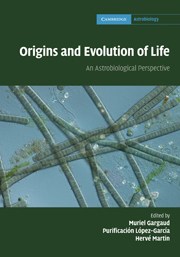Book contents
- Frontmatter
- Contents
- List of contributors
- Foreword
- Preface
- Part I What is life?
- Part II Astronomical and geophysical context of the emergence of life
- Part III The role of water in the emergence of life
- Part IV From non-living systems to life
- Part V Mechanisms for life evolution
- 19 Molecular phylogeny: inferring the patterns of evolution
- 20 Horizontal gene transfer: mechanisms and evolutionary consequences
- 21 The role of symbiosis in eukaryotic evolution
- Part VI Life in extreme conditions
- Part VII Traces of life and biosignatures
- Part VIII Life elsewhere?
- Index
21 - The role of symbiosis in eukaryotic evolution
from Part V - Mechanisms for life evolution
Published online by Cambridge University Press: 04 February 2011
- Frontmatter
- Contents
- List of contributors
- Foreword
- Preface
- Part I What is life?
- Part II Astronomical and geophysical context of the emergence of life
- Part III The role of water in the emergence of life
- Part IV From non-living systems to life
- Part V Mechanisms for life evolution
- 19 Molecular phylogeny: inferring the patterns of evolution
- 20 Horizontal gene transfer: mechanisms and evolutionary consequences
- 21 The role of symbiosis in eukaryotic evolution
- Part VI Life in extreme conditions
- Part VII Traces of life and biosignatures
- Part VIII Life elsewhere?
- Index
Summary
Conceptual and historical framework
Botanists of the late nineteenth century were already familiar with microbial symbioses. In fact, the term ‘symbiosis’, meaning literally ‘living together’ was introduced by Anton de Bary and Albert Bernard Frank discussing lichens and mycorrhizae, respectively, at the end of the 1870s. However, until recent times, the idea that microbial associations are central in evolution remained almost marginal. The historian Jan Sapp (1994) proposed several reasons for that situation, including the traditional accent on microorganisms as causative agents of diseases and the prominent concepts of conflict and competition as major evolutionary driving forces. Darwin's metaphoric use of the term ‘struggle for existence’ included the ‘dependence of one being on another’, and he actually recognized the existence of species taking advantage of another species, but also emphasized the difficulty for his natural-selection theory to explain the emergence of structures in one species to benefit another (Darwin, 1859, p. 200). Lynn Margulis' contributions since the late 1960s on a symbiotic theory for cell evolution bridged the previous intellectual gap, and proposals made by forgotten biologists that had been dismissed were reopened – especially those of the Russian botany school (Khakhina, 1992; Margulis, 1993). Today there is a wide consensus on the essential role played by symbiosis during the origin and evolution of eukaryotic cells, although very passionate and fundamental debates still persist (de Duve, 2007).
- Type
- Chapter
- Information
- Origins and Evolution of LifeAn Astrobiological Perspective, pp. 326 - 344Publisher: Cambridge University PressPrint publication year: 2011
- 2
- Cited by

